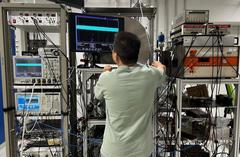URL: https://www.desy.de/news/news_search/index_eng.html
Breadcrumb Navigation
DESY News: How many water molecules does it take to dissolve hydrochloric acid?
News
News from the DESY research centre
How many water molecules does it take to dissolve hydrochloric acid?
Scientists from DESY have made a significant step towards understanding the solvation processes of hydrochloric acid (HCl) at the molecular scale. HCI is a prototypical acid that is often used for research and in industry and also plays a part in atmospheric chemistry – for example in the growth and formation of aerosol particles. A precise understanding of the chemical processes at the molecular level helps to predict atmospheric pollution and possibly control catalytic reactions.

Scientist Fan Xie in the lab where hydrochloric acid was put to the test. Image: DESY
Substances exhibit vastly different properties in their isolated gaseous forms compared to their condensed forms. For example, in the gas phase, HCl is a molecule with a covalent bond, but in solution with water, HCl dissociates to a chlorine (Cl-) anion and a hydrogen (H+) cation, which will combine with one of the surrounding water (H2O) molecules to a species called hydronium, H3O+. By adding single water molecules to the hydrochloric acid one by one, the scientists get a better picture of how this dissociation process occurs and how the size-dependent reactivity evolves. This is crucial for understanding various fundamental chemical processes at the molecular level, for example, the growth and formation of aerosol particles that contribute to atmospheric pollution or catalytic reactions on surfaces.
HCl is one of the most commonly used strong acids in research and industry. Previously, pioneering spectroscopic studies have successfully characterised the structures of clusters of HCl with up to three water molecules. At this stage of aggregation, the dissociation of HCl was not observed. With four or more water molecules, theoretical calculations predicted this dissociation of HCl. The corresponding HCl hydrates evolved into three-dimensional structures with many possible distinctive and alike arrangements. At room temperature, these structures quickly convert to each other. Hence it is challenging to capture and analyse these processes.
The group headed by Melanie Schnell used a supersonic expansion to freeze and isolate the structures of HCl-water clusters in a vacuum. During this supersonic expansion, the HCl and water molecules are expanded from conditions under high pressures to very low pressures in a vacuum chamber through a small pinhole. During this expansion process, the molecules collide with each other and with an inert carrier gas. These collisions result in a change of the internal energy of the molecules to highly directed kinetic energy. This way, the molecules get very cold, typcially 1-2 K, i.e., close to absolute zero, and at such a low temperature, the molecules begin to condense. They form clusters.
The HCl-water clusters were irradiated with microwave radiation to provide their rotational signatures. These rotational signatures carry the detailed structural information of the HCl-water clusters and thus allow to unambiguously identify the different structural arrangements. Most importantly, the coupling between the chlorine’s nuclear spin and the angular momentum of the clusters, which are associated with these rotational signatures, can be revealed with microwave spectroscopy as an additional characteristic hyperfine structure in the spectra. This hyperfine structure is strongly influenced by the electron distribution around the chlorine nucleus, i.e., its bonding situation. As a consequence, the analysis of this hyperfine structure gives direct information if the H-Cl unit in these clusters is covalently bonded or dissociated (ionic) – as a function of the number of surrounding water molecuels.
This research is strongly connected to the activities of the Centre for Molecular Water Science (CMWS), which addresses the role of molecular water in environments as diverse as climate, energy, and health.
Original publication:
"Electric nuclear quadrupole coupling reveals dissociation of HCl with a few water molecules", Fan Xie, Denis S. Tikhonov and Melanie Schnell, DOI: 10.1126/science.ado7049



